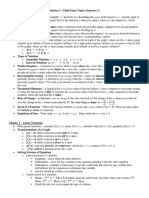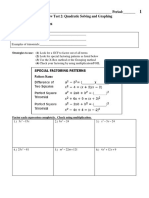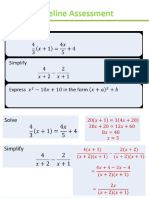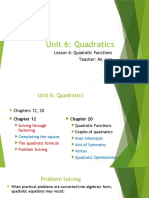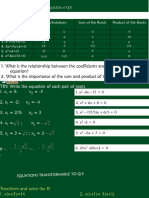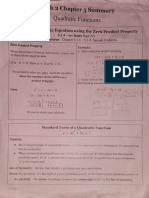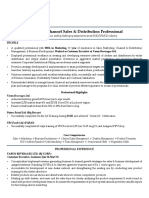Analysis
and
Approaches
SL
Unit 2b – Modelling Relationships:
Linear and Quadratic Functions
Unit 2b - Overview
Before we start!
Gradient of a Linear Function
Gradient of a Linear Function
Gradient of a Linear Function 3A
Gradient Relationships
Gradient Relationships 3B
Parameters of a Linear Graph
Equation?
y = 2x - 1
Parameters of a Linear Graph -
Example
Parameters of a Linear Graph - 3A-
Example C
𝒚 =𝟐
𝒙=− 𝟒 𝒙 =− 𝟏 𝒙 =𝟐
𝒚 =−𝟏
𝒚 =−𝟒
Equations?
Linear Functions
Which is the correct equation?
1 1
𝑥 −2 𝑦=6 𝑦= 𝑥−3 𝑦 + 2= ( 𝑥 − 2)
2 2
Different forms of Linear
Functions
1
𝑦= 𝑥−3
2
1
𝑦 + 2= ( 𝑥 − 2)
2
𝑥 −2 𝑦=6
Different forms of Linear
Functions
Different forms of Linear
Functions
Different forms of Linear 3D
Functions +E
Different forms of Linear Functions
Intersection of Linear Functions
Intersection of Linear Functions 3
F
Linear Functions 3
G
𝑓 ( 𝑥 ) =2 𝑥 − 4
Find
𝑓 ( 3) ¿2
( 𝑓𝑜𝑓 ) ( 𝑥 ) ¿ 4 𝑥 −12
−1 𝑥+ 4
𝑓 ( 𝑥) ¿
2
Domain and Range 𝑥 ∈ ℝ , 𝑦 ∈ℝ
Linear Functions 3
H
Linear Models
Linear Models 3I
Exercises
Sections covered today:
Intersection of two lines using your GDC:
3F
Function Notation and Inverse functions
3G+H
Linear Models: 3I
Special Functions and their
Graphs
Special Functions and their
Graphs
Transformations of Quadratics
The simplest form is y =
x2
We will look at various
different transformations
on the graph y = x2
Transformations
Transformations
Transformations
Transformations
Transformations
Transformations
Transformations 3
J
Transformations
General Transformations
Function Transformations -
Investigation
Function Transformations -
Investigation
Investigate the transformations of the graph y = f(x) + b, and
Graph Transformations 1 how this affects the graph of y = f(x).
Investigate the transformations of the graph y = f(x + a), and
Graph Transformations 2 how this affects the graph of y = f(x).
Combine the two transformations above. Can you find the
Graph Transformations 3 points?
Investigate the transformations of the graph y = cf(x), and
Graph Transformations 4 how this affects the graph of y = f(x).
Investigate the transformations of the graph y = f(dx), and
Graph Transformations 5 how this affects the graph of y = f(x).
Put everything you have learnt about graph transformations
Graph Transformations 6 together in this activity, which combines all four
transformations we have seen.
f(x) Transformation
f(x)+a Translation vertically by a units
f(x+a) Translation horizontally by -a units
-f(x) Reflection in the x-axis
f(-x) Reflection in the y-axis
f (x)
-1 Reflection in the line y=x
pf(x) Vertical stretch by a factor of p
1
f(px) Horizontal stretch by a factor of .
p
Function Transformations
Y = f(x) is any function or
equation of a graph.
This example is an cubic
function/equation. y = f(x)
Function Transformations
y = f(x) + a
y = f(x)
+a
Point (x, y)
becomes point (x,
y+a)
y = f(x) + a
This is a ‘shift’ in the y-direction
Function Transformations
y = f(x)
y = f(x+a)
-a
Point (x, y)
becomes point (x-
a, y)
y = f(x+a)
This is a ‘shift’ in the x-direction, opposite to the sign of number a
Function Transformations
y = f(x)
y = -f(x)
y = -f(x)
This is a ‘reflection’ in the axis, mirror line y = 0
Every y coordinate gets multiplied by -1
Function Transformations
y = Af(x)
y = f(x)
Notice what
happens at the
zeros
y = Af(x)
This is a ‘stretch’ in the y-direction, Scale factor A.
Every answer (y-coordinate) gets multiplied by A
Function Transformations
Notice what y = f(Ax)
happens at the
y-intercept y = f(x)
y = f(Ax)
This is a ‘stretch’ in the x-direction, Scale factor 1/A
Every x coordinate gets multiplied by 1/ , y values stay the same
Summary - Function
Transformations
Piecewise Functions -
Transformations
Piecewise Functions - 3
Transformations K
Sketching Quadratics 3L
When you sketch a Parabola, your sketch should
show the general shape and:
The coordinates of the x and y intercept
The coordinates of the vertex
The equation of the axis of symmetry
𝑥=1
(1 , 8)
Sketch:
(−1 , 0) (3 ,0)
Vertex Form
2 −1 − 4
1
− 2 5
2
−3 1 −6
Vertex Form
General Form
𝑥=1
−4
𝑥= =1
2(−2)
2
𝑦 =− 2 ( 1 ) + 4 ( 1 ) + 6= 8
𝑉𝑒𝑟𝑡𝑒𝑥=(1 , 8)
General Form
General Form
Factorised Form
𝑦 =− 2(𝑥+1)(𝑥 − 3) 𝑥=1
−1+3 2
𝑥= = =1
2 2
Axis of symmetry
𝑦 =− 2 ( 1+1 ) ( 1 −3 )=8
𝑉𝑒𝑟𝑡𝑒𝑥=(1 , 8)
Factorised Form
Summary 3
M
Summary Question – What's the
Equation?
Changing forms
Changing forms 3
N
Find the Quadratic function
𝑦 =2( 𝑥 +2)( 𝑥 −1) 𝑦 =− 2 ( 𝑥 − 1 )2+ 5
Fitting the Quadratic 3
O
Solving Quadratics
A quadratic can only be solved if there is an = sign in the equation,
otherwise it is an expression.
List all the methods you know to solve a quadratic equation.
Factorise (bring in brackets)
Use the formula:
Graph it using your GDC
and find the roots.
Use the equation solver on
GDC
Completing the square (we
will cover this later).
Factorizing
Factorising requires finding common factors and
adding brackets.
Find 2 numbers that:
Add to give -7 and multiply to give +12
This will give -3 and -4.
Alternative Method
This is used when we have harder expressions to factorise.
Divide the function by a
Find 2 numbers whose product is ac
and whose sum is b.
ac=6,b=-7, two numbers are -6 and -1
These numbers factorise with each
bracket starting with ax, and finish with
the two numbers from above.
Now take out any common factors from
the any of the brackets and cancel with
the denominator.
x 32x 1 Now we have our final answer.
Solving After Factorising 3P+Q
Now to solve quadratics that have been factorised:
This is the equation we have already factorised.
Take the first bracket, make it equal to 0 and
solve.
Do the same with second bracket, make it
equal to 0 and solve.
Now solve the second quadratic we had.
The answers 1
are:
x 3 and x
2
Perfect Squares
Multiply out the brackets:
a) (x+3)(x+3)
b) (x+2)2
c) (x+5)2
Factorise:
d) x2 +8x + 16
e) x2 + 12x + 36
f) x2 + 22x + 121
Perfect Squares
Where Functions Meet
Intersections 3
R
Completing the Square
x2 + 6x
Take half of the coefficient of ‘x’3
Square it and add it9
x + 6x + 9 = (x + 3)
2 2
Completing the Square
Complete the square, and show what the
perfect square is:
2 2
x 12 x x 12 x 36 x 6 2
2
y 14 y 2
y 14 y 49 y 7 2
2
y 10 y 2
y 10 y 25 y 52
2
2
x 5x 2 25 5
x 5x x
4 2
Completing the Square
2
x 6 x 16 0
2
x 6 x 16
+9 +9
2
x 6 x 9 25
x 3 25
2
x 3 25 0
2
Completing the Square
2
x 10 x 4 0
2
x 10 x 4
+25 +25
2
x 10 x 25 29
x 5 29
2
x 5
2
29 0
Completing the Square
2
x 8 x 11 0
2
x 8 x 11
+16 +16
2
x 8 x 16 5
x 4 5
2
x 4
2
5 0
Completing the Square
2
x 6 x 4 0
2
x 6 x 4
+9 +9
2
x 6 x 9 5
x 3 5
2
x 3 2
5 0
Completing the Square (a1)
2
2 x 3x 3 0
2 2 2 2
3 2 3
x x 0
2 2
2 3 3 3 3
x x 2
2 2 2 4
2
2 3 9 3 9 3 33
x x x
2 16 2 16 4 16
Completing the Square
2
3 x 12 x 1 0
2 1
x 4 x
3
2 1
x 4 x 4 4
3
11
x 2
2
3
Completing the Square
1. Introduce an = sign and
then eliminate c from the left
hand side.
2. Write down the value of
and and , keeping your
values as fractions.
3. Add to both sides of the
equation.
4. The left and side will now
factorise into .
5. Eliminate the number from
the right hand side and get
rid of the = sign you
introduced in 1.
Completing the Square
2
1. Take the factor of a, out of your expression, 2x 5x 12
keeping your answers as fractions. 2 5
2x x 6
2
2. ‘Discard’ a for now. We will use it later. Treat
the inside of your bracket as an expression and 2 5
use the same method as before. x x 6
2
5
3. Introduce an = sign and then eliminate c from 2
x x 6
the left hand side. 2
4. Write down the value of and , keeping your
values as fractions.
5. Add to both sides of the equation.
6. The left and side will now factorise into .
7. Eliminate the number from the right hand side
and get rid of the = sign.
8. Now multiply the equation out by a as shown in
the example.
Completing the Square
2
Write each of the following in the form 3. f ( x) =2x 10x 1
a( x + p) 2 +q. 2 1
2x 5x
2
1. f ( x) = x 2 6x 2 2
x 5x
1
2
2
x 6x 2 x 2 5x
25 23
4 4
x 2 6x 9 7 5 2 23
x
2 2 4
x 3 7 2
5 23
2x
2 2
2
2. f ( x) = x 8x 5 2 4. f ( x) = 3x 12x 5
2 5
3x 4 x
x 2 8x 5 3
2 5
x 8x 16 21 2
x 4 x
3
2
x 4 21 x2 4x 4
7
3
2 7
x 2
3
2
3x 2 7
Completing the Square 3S+T
Quadratic Formula
A quadratic formula is given as
a, b, and c are the coefficients, the given numbers.
to give 2
Use the formula:
answers.
Try using the formula to solve the quadratic:
a=2, b=-7, c=3
1
Final answers are x 3 and x
2
How many solutions
These graphs have either 2 solutions, 1 repeated solution or 0
solutions. Which is which?
0 solutions
2 solutions
1 repeated solution
The Discriminant
The Discriminant
2
b 4ac 0 2 solutions
2 1 repeated
b 4ac 0 solution
2
b 4ac 0 0 solutions
The Discriminant
Using the discriminant to solve typical examination questions 1
2
b 4ac 0 2 solutions As there is 1 repeated solution use
the highlighted formula.
b 2 4ac 0 1 repeated solution
2
k (4 1 9) 0
2
b 4ac 0 no solutions 2
k 36
Find the value(s) of k in the following
quadratic given the quadratic has 1 k 6, 6
repeated solution.
2
x kx 9 0
The Discriminant
Using the discriminant to solve typical examination questions 2
As there are 2 solutions use the
b 2 4ac 0 2 solutions highlighted formula
2
b 4ac 0 1 repeated solution k 2 (4 2 8) 0
k 2 64
b 2 4ac 0 no solutions
Find the range of values for k in the k 8 and k 8
following quadratic given the
quadratic has 2 distinct solutions.
Be careful with the negative answer,
2
and the change of sign.
2x kx 8 0
The Discriminant
Using the discriminant to solve typical examination questions 3
b 2 4ac 0 2 solutions As there are 0 solutions use the
highlighted formula.
2
b 4ac 0 1 repeated solution 2
k (4 9 4) 0
2
2
b 4ac 0 no solutions k 144
Find the range of values for k
in the
following quadratic given the k 12 and k 12
quadratic has 0 solutions.
Again, be careful with the negative
2
9x kx 4 0 answer, and the change of sign.
The Discriminant 3U+
V
Quadratic Inequalities
Example: Solving Quadratic Equations by Using
Algebra
Solve the inequality x2 – 10x + 18 ≤ –3 by using
algebra.
Step 1 Write the related equation.
x2 – 10x + 18 = –3
Quadratic Inequalities
Example Continued
Step 2 Solve the equation for x to find the critical
values.
x2 –10x + 21 = 0 Write in standard form.
(x – 3)(x – 7) = 0 Factor.
x – 3 = 0 or x – 7 = 0 Zero Product Property.
x = 3 or x = 7 Solve for x.
The critical values are 3 and 7. The critical values
divide the number line into three intervals:
x ≤ 3, 3 ≤ x ≤ 7, x ≥ 7.
Quadratic Inequalities
Example Continued
Step 3 Test an x-value in each interval.
Critical values
x2 – 10x + 18 ≤ –3
–3 –2 –1 0 1 2 3 4 5 6 7 8 9
Test points
(2)2 – 10(2) + 18 ≤ –3 x Try x = 2.
(4)2 – 10(4) + 18 ≤ –3 Try x = 4.
(8)2 – 10(8) + 18 ≤ –3 x Try x = 8.
Quadratic Inequalities
Example Continued
Shade the solution regions on the number line. Use
solid circles for the critical values because the
inequality contains them. The solution is 3 ≤ x ≤ 7
or [3, 7].
–3 –2 –1 0 1 2 3 4 5 6 7 8 9
Quadratic Inequalities – You try!
Solve the inequality by using algebra.
x2 – 6x + 10 ≥ 2
Step 1 Write the related equation.
x2 – 6x + 10 = 2
Quadratic Inequalities
Step 2 Solve the equation for x to find the critical
values.
x2 – 6x + 8 = 0 Write in standard form.
(x – 2)(x – 4) = 0 Factor.
x – 2 = 0 or x – 4 = 0 Zero Product Property.
x = 2 or x = 4 Solve for x.
The critical values are 2 and 4. The critical values
divide the number line into three intervals:
x ≤ 2, 2 ≤ x ≤ 4, x ≥ 4.
Quadratic Inequalities
Step 3 Test an x-value in each interval.
Critical values
x2 – 6x + 10 ≥ 2
–3 –2 –1 0 1 2 3 4 5 6 7 8 9
Test points
(1)2 – 6(1) + 10 ≥ 2 Try x = 1.
(3)2 – 6(3) + 10 ≥ 2 x Try x = 3.
(5)2 – 6(5) + 10 ≥ 2 Try x = 5.
Quadratic Inequalities
Shade the solution regions on the number line. Use solid
circles for the critical values because the inequality
contains them. The solution is x ≤ 2 or x ≥ 4.
–3 –2 –1 0 1 2 3 4 5 6 7 8 9
Quadratic Inequalities 3
W
Remember!
A compound inequality such as 12 ≤ x ≤ 28 can
be written as {x|x ≥12 U x ≤ 28}, or x ≥ 12 and x
≤ 28.
Quadratic Applications
A ball is thrown vertically upwards into the air. The height, h
metres, of the ball above the ground after t seconds is given
by
h = 2 + 20t – 5t 2, t ≥0
(a) Find the initial height above the ground of the ball (that is, its
height at the instant when it is released).
(2)
(b) Show that the height of the ball after one second is 17 metres.
(2)
(c) At a later time the ball is again at a height of 17 metres.
(i) Write down an equation that t must satisfy when the ball
is at a height of 17 metres.
(ii) Solve the equation algebraically.
Quadratic Applications
Quadratic Applications 3X
Using your GDC
You can use the GDC to draw a graph and solve where
the curve crosses the y-axis.
Using your GDC
You can use the GDC to draw a graph and solve where
the curve crosses the y-axis.
Summary
Summary


















